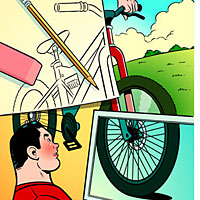Originally published in September 2011. Original article can be found here.
Bike Shopping
How To Buy A Bike
Follow this advice and you'll ask the right questions, pick your dream ride and get a great deal.
ByBrian Fiske
 BEFORE YOU GO
BEFORE YOU GO
Sketch yourself. Grab a pencil, paper and some brutal honesty. Now make two lists. The first is an inventory of your current status as a cyclist or, for first-timers, your fitness level: how competitive you are, how much time you spend riding (or working out) each week, your highest achievements on a bike. The second is your ultimate vision of yourself as a cyclist: completing multiple charity rides each year, kicking butt on the local race circuit, riding to work every day, and so on. Then, imagine a rider who fits between the two—the bike that's right for that middle-ground you is the minimum you should purchase. Buy below that level, and you won't have enough room to grow.
Get on the horn. Look up the bike shops closest to you. Convenience isn't the deciding factor when choosing a shop, but the ideal shop is one that's easy to reach. Then call at least two or three of them. Note what brands the shop carries. Ask whether the shop specializes in a particular bike style—if you're looking for a road bike and the shop carries mostly mountain bikes, it's probably not a good fit. Also, ask what kind of service plan the shop offers on a new bike purchase; a year of free tune-ups is a good starting point.
Click and read. Hit the websites of your chosen brands, which tend to be organized so that it's easy to find the bikes that match your intended riding style. Study frame materials, components (wheels, derailleurs and cranks in particular--you can spot them right away on the bikes at the shop) and price, if it's listed. A model line will often have the same frame, with more expensive wheels and parts as the bike prices go up. Frames last longer than components, so we generally recommend investing in a higher-quality frame worthy of parts upgrades later, if need be.
Tap the locals. Ask your cyclist friends what they like and don't like about their current bikes; you can judge by their riding style whether you should have the same concerns. Also, ask for opinions on local shops or the bike models you found on the Internet. If you don't know many cyclists, e-mail a local cycling club. Bonus: You'll have people to ride with when you have your new bike.
AT THE SHOP
Stroll the floor. Check out the models you've researched. Eyeball those easy-to-spot components, and note if they don't match the specs you saw online. Similar-level components from a different manufacturer shouldn't be a concern. If you see lower-level components than those stated on the web, with no corresponding drop in price, ask why.
Choose your champion. If a salesman hasn't approached you, seek one out. Talk about what you're looking for, and the models you've researched. The reaction should be along the lines of, "I can show those to you, and I have a couple of others you should look at."
If you feel like you're being pushed to look at a bike that doesn't suit you, a race bike when you don't race, or a cruiser when you plan to ride a serious commute, hold your ground or head to another shop. But if the salesperson listens to your goals and recommends a slightly different bike style than you were considering--say, one with a more upright position versus a more stretched-out ride--just ask why. There may be a good reason for the switch.
Look up and down. Check out the bikes a step above and a step below the bike you like most. Ask your salesman about the pros and cons of the frame material, components, rider position and intended use of each bike. If the bike you're considering still seems to be the best fit at the best price, you may have a winner.
Take a ride. A quick test spin around the block won't be enough to completely judge the bike's performance, but you'll be able to find any glaring fit problems. Be sure the saddle is set so that you have a slight bend to your knee at the bottom of the pedal stroke. Ask yourself these key questions: Does my upper body feel cramped, or too stretched out, when I'm on flat road? Does the bike feel unstable or twitchy when I turn? Is the reach to the brake levers comfortable? Is it awkward to go from sitting to standing on a hill?
Get a deal. Maybe. A good rule to follow when it comes to price negotiations: Be reasonable. A bike shop is a tough business--people work there because they love bikes, not because they want to get rich. If you're buying a relatively inexpensive bike (less than $800, where profit margins are razor-thin) or an in-demand, new-model-year bike, you might be able to finagle a longer free-service contract, but don't expect a price cut. However, if you're buying a more expensive bike, more than one bike, a model left over from last year, or a package including a helmet, tools, shoes, pedals, shorts and more, there's no harm in asking for a small discount. The worst you'll hear is no, but you may hear yes.
ONCE YOU'RE HOME
Take a break-in ride. Plan for your maiden ride to last about an hour, and leave time to stop to fiddle with your seat height, or make other minor adjustments. The whole idea is to familiarize yourself with the shifting, braking and ride feel without going on an epic.
Do the twist. If the shifting is off, or your brakes feel soft after your first ride, don't worry. It's because the cables have stretched or the housing has wiggled a little farther into position--common occurrences when a bike is first used. A careful, counterclockwise twist of the barrel adjuster connected to the offending component should make things work smoothly again. While you're at it, check that the brake pads are still lined up so that they contact only the rim when you apply the brakes. Confused? No big deal. Just take your bike to the shop for your first free service call.
Call. Visit. Upgrade. Repeat. Your shop is your ally. Have a question about your bike? Give the shop a call. Something feel amiss on a ride? Stop by with your bike and chat with someone. A tune-up or a specific accessory could get things back in line and keep you riding. And that's the best deal around.

 BEFORE YOU GO
BEFORE YOU GO